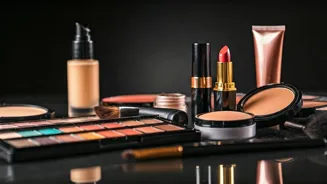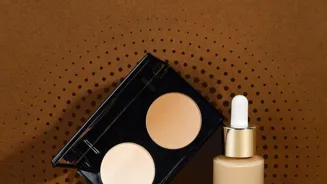Prep the Skin
The foundation for a flawless makeup application begins with meticulous skin preparation. Makeup artists emphasize the importance of a well-hydrated, primed
canvas. Begin by cleansing the face thoroughly to remove any impurities. Next, apply a hydrating moisturizer suitable for your skin type, allowing ample time for it to absorb completely. Following the moisturizer, use a primer formulated to address specific skin concerns, such as minimizing pores or controlling shine. Properly preparing the skin creates a smooth surface, enabling the foundation to adhere evenly and last longer, avoiding patchiness and ensuring a natural appearance. This foundational step is crucial for achieving a professional-looking makeup application and preventing foundation from caking or separating throughout the day.
Choose the Right Formula
Selecting the right foundation formula tailored to your skin type is a cornerstone of achieving a smooth, even finish. If you have dry skin, opt for hydrating foundations with ingredients like hyaluronic acid or ceramides to combat dryness and prevent patchiness. For oily skin, choose oil-free or mattifying foundations that help control shine and prevent the foundation from sliding. Combination skin benefits from foundations that balance both hydration and oil control. Regardless of skin type, always look for a formula that offers buildable coverage, allowing you to adjust the intensity as needed. Consider factors like the climate and your daily activities. A breathable formula is preferable for warm weather. This approach ensures the chosen foundation complements your skin, promoting a seamless, long-lasting appearance.
Application Techniques Matter
The tools and techniques you use for applying foundation significantly impact the final result. Makeup artists often recommend using a damp makeup sponge for a natural, airbrushed finish. Gently tap the sponge across the skin, rather than swiping, to blend the foundation seamlessly. A brush, like a flat-top or stippling brush, can be used for medium to full coverage. Apply the foundation in thin layers, building up coverage gradually to prevent a heavy, cakey look. Starting with a small amount of product, applying it to the center of the face and blending outward, is a standard technique. This ensures the most coverage is applied where it is needed most, naturally diminishing toward the edges. Furthermore, blending the foundation onto the neck and hairline is critical for avoiding harsh lines and maintaining a unified skin tone, resulting in a smooth and professionally done look.
Strategic Layering
Mastering the art of layering is an effective method for building coverage while maintaining a natural appearance. Apply a thin layer of foundation, then assess any areas requiring extra coverage. Instead of applying a thick layer, apply additional product only to specific areas, such as blemishes or areas with uneven pigmentation. Use a small brush or the edge of a damp sponge for targeted application. This technique minimizes the chance of the foundation caking and allows for a more seamless blend. Furthermore, setting the foundation with a translucent powder between layers can provide extra coverage and set the foundation in place, extending its staying power. Remember that less is more; the key is to create a flawless base by building coverage strategically rather than applying a single thick layer.
Correcting Color Imperfections
Color correction is a critical step for tackling uneven skin tones and other imperfections. Use color-correcting products, such as concealers or primers, before applying foundation to neutralize specific issues. Green color correctors can counteract redness, while peach or orange tones can camouflage dark circles or hyperpigmentation. Purple correctors brighten dull skin, while yellow correctors tone down any purple hues. Apply a small amount of color corrector to the targeted areas, blend it gently, and allow it to set before applying the foundation. This technique ensures a more uniform skin tone. A good color-correcting strategy will minimize the appearance of blemishes, dark spots, and redness. The result will be a more balanced base and even skin tone.
Setting with Powder
Setting your foundation with powder is critical for achieving a long-lasting, professional look. A translucent setting powder is usually preferred as it doesn't add any color, allowing your foundation's shade to stay true. Use a large, fluffy brush or a makeup sponge to apply the powder evenly. Focus on areas prone to oiliness, such as the T-zone, to absorb excess shine and prevent the foundation from creasing or sliding. Baking with powder under the eyes and in other areas requiring extra hold can also enhance the staying power. After applying the powder, gently dust off any excess with a clean brush, leaving a smooth, matte finish that will keep your makeup in place all day. Choosing the correct powder formula will help prevent any unwanted texture and ensure the foundation remains intact.
Blot and Touch-Ups
Carrying blotting papers and touch-up products is an essential habit for maintaining a flawless finish. Throughout the day, your skin may become oily, causing your foundation to break down or appear patchy. Blotting papers absorb excess oil without disturbing your makeup. Carry a compact mirror and your foundation to perform quick touch-ups. Apply a small amount of foundation where necessary, blending it gently to maintain a smooth, uniform appearance. Using a setting spray can also lock in your makeup and prevent it from fading or settling into fine lines. These touch-up strategies can ensure that your makeup looks fresh throughout the day. This makes you look and feel your best without a complete reapplication of your base.
Choosing the Right Concealer
Pairing the right concealer with your foundation is vital for achieving an impeccable appearance. Select a concealer with a similar undertone to your foundation and skin tone. You can use a concealer a shade or two lighter than your foundation to brighten under-eye areas and conceal imperfections. Apply the concealer with a small, precise brush or a makeup sponge. Gently pat, rather than rubbing, to avoid disturbing the foundation underneath. Ensure the concealer is blended seamlessly with the foundation to eliminate any harsh lines or obvious patches. Setting your concealer with a translucent powder is also critical to extending its staying power and preventing it from creasing or moving. A well-chosen and skillfully applied concealer enhances the overall finish, creating a polished look.
Hydration is Key
Keeping your skin hydrated is essential for preventing patchy foundation. Drinking adequate water and maintaining a skincare routine with hydrating ingredients can help maintain your skin's moisture balance. Apply a hydrating moisturizer before applying your foundation to create a smooth surface. Throughout the day, use a hydrating mist or facial spray to refresh your skin. These mists can help restore moisture and keep your makeup from looking dry. Regular exfoliation is critical for getting rid of dead skin cells, allowing foundation to apply more evenly. Hydrated and healthy skin is more likely to hold the foundation and prevent patchiness. Ensure your makeup products work in tandem with your skincare routine for optimum outcomes.
Expert Techniques
Makeup artists use several other techniques to achieve flawless foundation application. One common method is to use a mixing medium or makeup oil to thin down the foundation formula, particularly if it is too thick or drying. This makes the foundation easier to blend and reduces the chances of caking or patchiness. Another tip is to set the entire face with a setting spray after applying all makeup. These sprays create a protective barrier, preventing the foundation from fading. Using a setting spray with hydrating properties is useful for maintaining moisture and avoiding a dry, cakey appearance. Learning the best techniques will allow you to adjust your foundation routine to achieve the desired look while ensuring a professional, long-lasting finish.








